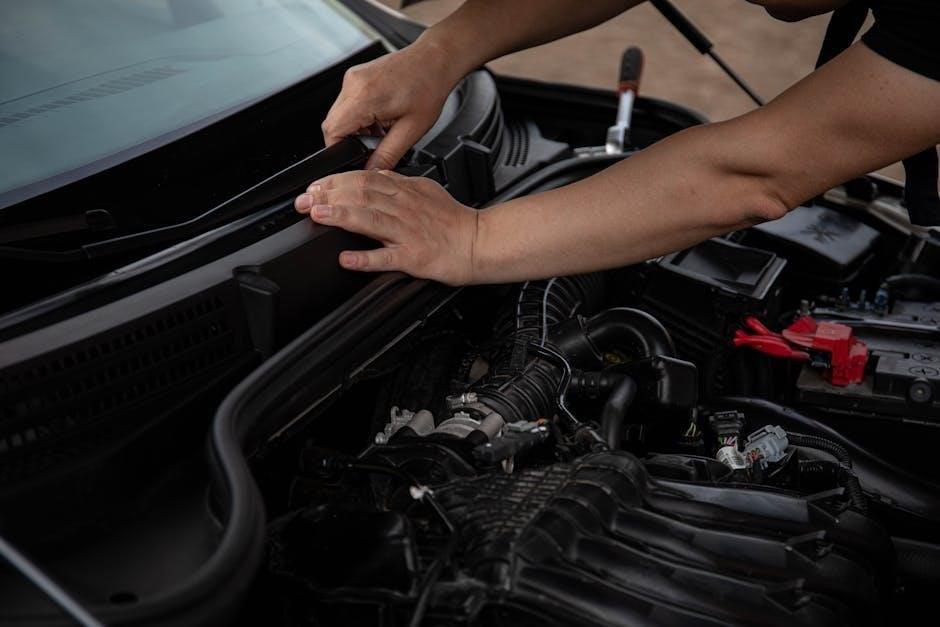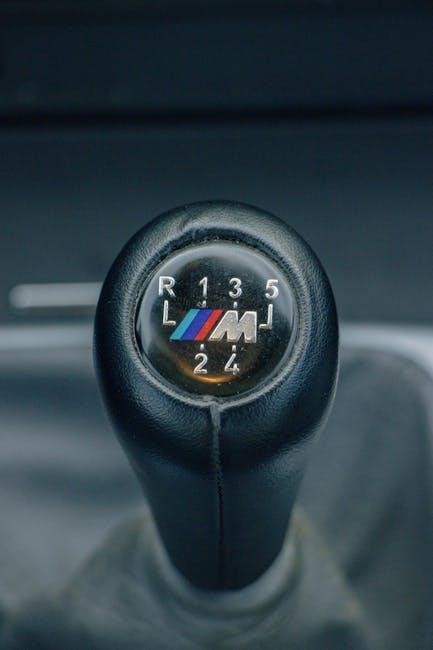Manual and CVT transmissions offer distinct driving experiences, affecting performance, fuel efficiency, and maintenance needs. This guide helps readers understand their differences for informed decisions.
1.1. Overview of Manual Transmission
A manual transmission, also known as a stick shift, is a driver-controlled gearbox requiring manual operation. It uses a clutch pedal and gearshift to change gears, offering precise control over speed and torque. This mechanical system relies on driver input, making it engaging for enthusiasts. Manual transmissions are known for their simplicity, durability, and cost-effectiveness. They often provide better fuel efficiency in skilled hands and are preferred for performance driving. However, they require practice to master and may not suit all driving conditions or preferences.
1.2. Overview of CVT Transmission
A CVT (Continuously Variable Transmission) is an automatic transmission that uses pulleys and a belt to provide an infinite number of gear ratios. It eliminates fixed gears, allowing seamless transitions between speeds. CVTs optimize engine RPM for better fuel efficiency, especially in city driving. They offer smooth acceleration and are ideal for stop-and-go traffic. However, CVTs lack the driver engagement of manuals and can feel unusual due to the absence of gear shifts. They are favored for their simplicity and efficiency but may not suit performance-oriented drivers.
1.3. Importance of Understanding the Differences
Understanding the differences between manual and CVT transmissions is crucial for making informed decisions. Manuals offer control and performance, while CVTs prioritize efficiency and convenience. Drivers must consider their lifestyle, driving habits, and priorities. Fuel efficiency, maintenance needs, and cost vary significantly between the two. Recognizing these distinctions helps buyers choose the best fit for their needs, ensuring satisfaction and optimal performance. Whether seeking thrill or practicality, knowing the pros and cons guides smarter choices in selecting the right transmission type.
Key Characteristics of Manual Transmission
Manual transmissions offer driver engagement and control, requiring clutch pedal and gear shifting. They provide better fuel efficiency in city driving but can be less convenient.
2.1. How Manual Transmissions Work
Manual transmissions require drivers to use a clutch pedal and gearshift to change gears. Pressing the clutch disengages the engine from the transmission, allowing smooth gear shifts. Releasing the clutch while accelerating connects the engine again. This mechanical process provides direct control over power delivery and torque, enhancing driver engagement. Improper use, like “riding the clutch,” can wear it out faster. The system relies on driver skill to optimize performance and efficiency, making it a preferred choice for those who enjoy an interactive driving experience.
2.2. Pros of Manual Transmission
Manual transmissions offer superior fuel efficiency, lower purchase costs, and greater driver control. They provide a more engaging driving experience, with precise gear shifts enhancing performance. Manuals are lighter and simpler, reducing energy loss and improving acceleration. They are preferred for sports and performance driving due to direct power delivery. Additionally, manuals often require less maintenance than automatics and can last longer if driven properly. This makes them a popular choice for enthusiasts and those seeking a more connected driving experience.
2.3. Cons of Manual Transmission
Manual transmissions require more driver effort, as constant gear shifting can be tiring in heavy traffic. They demand more skill and attention, especially in hilly or stop-and-go conditions. Additionally, improper clutch usage can lead to wear and tear, increasing maintenance costs. Manual transmissions also lack the convenience of automatic shifting, making them less ideal for urban commuting. Furthermore, they are not as smooth in low-speed scenarios, which can be a drawback for some drivers. This makes them less suitable for those prioritizing comfort and ease of use.

Key Characteristics of CVT Transmission
CVT transmissions use pulleys and belts for seamless shifting, offering infinite gear ratios. They optimize fuel efficiency and provide smooth acceleration, ideal for urban driving conditions.
3.1. How CVT Transmissions Work
A CVT (Continuously Variable Transmission) operates using a belt or chain and two variable-diameter pulleys. As the pulleys adjust their diameters, the gear ratio changes seamlessly without fixed shifts. This setup allows the engine to maintain optimal RPM, enhancing fuel efficiency and smooth acceleration. Unlike manual or traditional automatic transmissions, CVTs do not have fixed gear ratios, enabling infinite adjustments to power delivery. Electronic controls manage the pulley ratios, ensuring smooth transitions and consistent performance across driving conditions.
3.2. Pros of CVT Transmission
CVT transmissions offer exceptional fuel efficiency by maintaining optimal engine RPM, reducing energy loss during gear shifts. They provide smooth, seamless acceleration without the abrupt transitions of traditional automatics. CVTs are also lightweight and compact, making them ideal for smaller vehicles. Their simplicity reduces production costs, often resulting in lower purchase prices. Additionally, CVTs excel in stop-and-go traffic, offering a comfortable and stress-free driving experience. These benefits make CVTs a practical choice for drivers prioritizing efficiency and convenience.
3.3. Cons of CVT Transmission
CVT transmissions often lack the driver engagement and precise control of manual gearboxes. They can feel unnatural due to the constant engine RPM without traditional gear shifts. Additionally, CVTs may struggle with heavy loads or towing, as they lack fixed gear ratios. Some drivers find the “rubber band” sensation unpleasant. Repair costs for CVTs can also be higher than for manuals, and their long-term reliability is less proven compared to traditional automatics. These factors make CVTs less appealing for performance-oriented or heavy-duty driving scenarios.
Performance Comparison
Manual transmissions excel in acceleration and driver control, while CVTs optimize engine RPM for fuel efficiency, offering smooth power delivery but less direct engagement for performance driving.
4.1. Acceleration and Power Delivery
Manual transmissions typically deliver faster acceleration and more direct power delivery due to their fixed gear ratios, allowing drivers to control shifts precisely. CVTs, however, prioritize smoothness and fuel efficiency by continuously adjusting the gear ratio to keep the engine at optimal RPM. While manuals provide a more engaging driving experience, CVTs can feel less responsive during hard acceleration because they lack distinct gear changes. This makes manuals better for performance driving, while CVTs excel in everyday commuting with their seamless power delivery.
4.2. Handling and Driver Engagement
Manual transmissions generally offer better handling and driver engagement due to their direct connection between the driver and the vehicle. The ability to manually shift gears provides a sense of control and precision, especially during cornering or spirited driving. CVTs, while smooth, often lack the same level of engagement due to their continuous gear ratio adjustments, which can feel less intuitive. Manuals are preferred by driving enthusiasts for their tactile feedback, while CVTs cater more to relaxed, everyday driving experiences with minimal driver input required.
4.3. Fuel Efficiency in Different Driving Conditions
Manual transmissions often excel in fuel efficiency during high-performance or varied driving conditions, as drivers can optimize gear shifts for better engine performance. CVTs, however, tend to shine in stop-and-go traffic and steady highway driving by maintaining optimal engine RPM. Manuals may struggle in heavy traffic due to frequent shifting, while CVTs provide seamless adjustments, enhancing efficiency in such scenarios. The choice between the two depends on the driver’s typical driving environment and priorities regarding fuel economy.
Maintenance and Lifespan
Manual transmissions require simpler, cost-effective maintenance, while CVTs offer longer lifespan with less wear in specific conditions but are more complex and expensive to repair when issues arise.
5.1. Maintenance Requirements for Manual Transmission
Manual transmissions generally require less complex maintenance compared to CVTs. Regular fluid changes and clutch inspections are essential, with clutches typically needing replacement every 50,000 to 100,000 miles. Driving habits significantly impact lifespan, as excessive clutch riding or aggressive shifting can reduce durability. Proper gear engagement and avoiding prolonged idling in gear help prolong transmission health. Overall, manual transmissions are simpler and more cost-effective to maintain, making them a practical choice for drivers seeking lower long-term ownership costs.
5.2. Maintenance Requirements for CVT Transmission
CVT transmissions require regular fluid changes with specialized synthetic fluids to maintain optimal performance. Inspections of the torque converter and belt or chain systems are crucial to prevent slippage or wear. Unlike manuals, CVTs often need software updates for smooth operation. Overheating can lead to premature wear, so monitoring temperature is essential. While CVTs are designed for low maintenance, repairs can be more complex and costly due to their intricate design. Proper care ensures longevity and prevents common issues like uneven acceleration or hesitation.
5.3. Lifespan Comparison
Manual transmissions generally have a longer lifespan compared to CVTs when properly maintained. Clutches may need replacement every 50,000 to 100,000 miles, but the transmission itself can last well over 200,000 miles. CVTs, while designed for durability, often experience issues sooner, especially if not serviced regularly. Their complex components, like belts and pulleys, can wear out faster, typically needing replacement within 100,000 to 150,000 miles. Driving conditions and maintenance habits significantly influence the lifespan of both types, with manuals often proving more robust in the long run.
Cost Considerations
Manual transmissions are typically cheaper to purchase and maintain, while CVTs may have higher repair costs but offer better fuel efficiency, affecting long-term expenses.
6.1. Purchase Price Comparison
Manual transmissions are generally more affordable to purchase upfront compared to CVT transmissions. Vehicles equipped with manual transmissions often have lower sticker prices, making them a cost-effective option for budget-conscious buyers. CVTs, while sometimes pricier initially, may offer better fuel efficiency, potentially offsetting higher purchase costs over time. Additionally, certain manufacturers like Honda and Subaru have historically offered both transmission types in their lineup, allowing consumers to choose based on their priorities for cost, performance, and efficiency.
6.2. Repair and Replacement Costs
Manual transmissions typically have lower repair and replacement costs compared to CVTs. Manual components like clutches are relatively inexpensive and straightforward to replace, with labor costs being manageable. CVTs, however, are more complex, with parts like belts and pulleys requiring specialized tools and expertise, leading to higher repair expenses. While CVTs may offer better fuel efficiency, their elevated repair costs can offset long-term savings. Manual transmissions often prove more cost-effective over time, especially when driven responsibly, as they tend to have a longer lifespan with proper maintenance.

Driving Experience
Manual transmissions offer driver engagement with precise control, while CVTs provide smooth, seamless acceleration. Manuals suit performance enthusiasts, whereas CVTs excel in traffic and fuel efficiency scenarios.
7.1. Manual Transmission: Driver Involvement
Manual transmissions foster a deeper connection between the driver and the vehicle. Engaging gears and using the clutch requires active participation, creating a more immersive driving experience. This hands-on approach allows for precise control over acceleration and deceleration, making manual cars feel more responsive. For enthusiasts, the tactile feedback of shifting gears enhances satisfaction and engagement, especially in performance or winding roads. This interactivity makes manual transmissions a preferred choice for drivers seeking a more involved and rewarding experience behind the wheel.
7.2. CVT Transmission: Smoothness and Convenience
CVT transmissions provide a smooth, seamless driving experience by eliminating fixed gear shifts. This results in consistent acceleration and a more relaxed feel, especially in stop-and-go traffic. The absence of abrupt gear changes makes CVTs ideal for city driving, offering a quieter and more comfortable ride. Additionally, CVTs are designed to optimize engine performance, keeping RPMs within an efficient range. This convenience appeals to drivers who prioritize ease of use and a hassle-free experience, making CVTs a practical choice for everyday commuting and urban environments.
7.3. Comparison in Stop-and-Go Traffic
In stop-and-go traffic, CVT transmissions excel by providing smooth, seamless acceleration without abrupt gear shifts. This reduces driver fatigue and offers a more comfortable experience. In contrast, manual transmissions require frequent clutch engagement and shifting, which can be tiring in heavy traffic conditions. The CVT’s ability to maintain optimal engine speed enhances fuel efficiency in such scenarios, making it a practical choice for city driving. However, manuals may feel more responsive for drivers who prefer control, even in traffic.
Reliability and Durability
Manual transmissions are known for their reliability and durability due to fewer components. CVTs have had historical reliability issues, though modern models show improvement.
8.1. Reliability of Manual Transmission
Manual transmissions are often praised for their reliability and longevity. With fewer complex components compared to automatic or CVT systems, they tend to experience less mechanical failure. The simplicity of their design means there are fewer parts that can wear out, reducing the likelihood of costly repairs. Additionally, manual transmissions are less prone to overheating and fluid-related issues, which are common in other transmission types. Proper driving habits, such as avoiding riding the clutch, can further extend their lifespan, making them a durable choice for many drivers.
8.2. Reliability of CVT Transmission
CVT transmissions have faced criticism for their reliability compared to manual or traditional automatics. Issues like slipping, hesitation, and unusual noises are more common, often linked to belt durability and software glitches. However, advancements in technology have improved their performance and lifespan. Manufacturers like Honda and Subaru have made strides in enhancing CVT reliability. Proper maintenance, including the use of specialized ATF, is crucial to prevent premature wear. While CVTs can be reliable for many drivers, they remain less robust than manuals in heavy-duty or high-stress driving conditions.
8.3. Common Issues with Each Type
Manual transmissions often face issues like clutch wear from heavy use or improper technique, leading to costly replacements. Synchronizer damage can occur due to aggressive shifting. CVTs, while smoother, may experience belt wear, slipping, or hesitation. Software glitches in CVTs can disrupt operation. Regular maintenance is crucial for both types to minimize these issues and extend lifespan. Understanding these common problems helps drivers make informed decisions based on their driving habits and needs.

When to Choose Manual vs. CVT
Choose manual for performance, control, and driving engagement, while CVT is ideal for fuel efficiency, smoothness, and convenience in stop-and-go conditions or highway driving.
9.1. Best for Performance and Control
Manual transmissions are preferred for performance and control, offering precise gear shifts and driver engagement. They provide better acceleration and responsiveness, making them ideal for spirited driving. CVTs, while efficient, lack the direct control and sporty feel of manuals. For drivers seeking a more connected experience, manuals excel, especially in vehicles like Honda and Porsche, renowned for their exceptional manual transmissions. CVTs, however, smooth out power delivery, which can be less engaging but more convenient in city driving. Choose manual for performance, CVT for smoothness.
9.2. Best for Fuel Efficiency and Convenience
CVT transmissions excel in fuel efficiency and convenience, making them ideal for city driving and stop-and-go traffic. By continuously adjusting gear ratios, CVTs optimize engine performance, ensuring the engine runs at its most efficient RPM. This results in better mileage compared to manual transmissions, especially in urban conditions. Additionally, CVTs provide smooth, seamless acceleration without the need for manual shifting, enhancing comfort and reducing driver fatigue. For drivers prioritizing efficiency and ease, CVTs are a practical choice, particularly in vehicles like Subaru, where CVTs are commonly utilized for their reliability and fuel-saving benefits.
9.3. Best for Specific Driving Conditions
Manual transmissions are ideal for hilly or mountainous terrains, offering better control and engine braking. CVTs, however, excel in heavy traffic and city driving, providing smooth acceleration without constant shifting. For highway driving, CVTs maintain optimal engine RPMs, enhancing fuel efficiency. Manuals are preferred for performance-oriented driving, where precise gear control is crucial. Ultimately, the choice depends on the driver’s primary driving environment and whether they prioritize control, convenience, or efficiency in their specific conditions.

Technological Advancements
Modern manual transmissions feature improved gear synchronizers and lightweight materials for smoother shifting. CVTs now incorporate advanced pulley systems and electronic controls for enhanced efficiency and performance.
10.1. Modern Manual Transmission Innovations
Modern manual transmissions have evolved significantly, offering smoother shifting and improved durability. Innovations include advanced gear synchronizers, lightweight materials, and optimized gear ratios for better performance. Some manufacturers now incorporate double-clutch systems and automated manual options, blending traditional manual control with modern efficiency. Additionally, coatings on gear surfaces reduce wear and tear, while electronic interfaces enhance driver engagement. These advancements ensure manual transmissions remain relevant, combining the classic driving experience with contemporary technological improvements for a more refined and responsive feel behind the wheel.
10.2. Modern CVT Transmission Innovations
Modern CVT transmissions have seen significant advancements, focusing on improved performance and efficiency. Innovations include optimized pulley systems, enhanced belt materials, and adaptive software controls for smoother power delivery. Some CVTs now incorporate torque vectoring and hybrid integration, enabling better fuel economy and reduced emissions. Additionally, advancements in noise reduction and mechanical efficiency have addressed traditional CVT drawbacks. These innovations make CVTs more versatile, offering seamless acceleration and enhanced driver satisfaction while maintaining their core benefits of fuel efficiency and convenience.
The choice between manual and CVT transmissions depends on personal preferences, driving habits, and priorities. Manuals offer control and performance, while CVTs provide convenience and efficiency.
11.1. Final Thoughts on Manual vs. CVT
When deciding between manual and CVT transmissions, consider your priorities. Manuals offer unparalleled driver engagement and control, ideal for enthusiasts, while CVTs provide smooth, efficient performance, perfect for everyday commuting. Manuals typically require more skill and maintenance, but they often cost less and last longer. CVTs, though less engaging, excel in fuel efficiency and convenience, especially in stop-and-go traffic. Ultimately, choose based on your driving habits, budget, and whether you value performance or practicality. Both options have their strengths, so weigh them carefully.
11.2; Recommendations for Buyers
For buyers prioritizing performance and driving engagement, manual transmissions are ideal, offering precise control and a more connected experience. However, those seeking convenience and fuel efficiency, especially in urban or stop-and-go conditions, should consider CVTs. Budget-conscious buyers may lean toward manuals for lower purchase costs, while CVTs appeal to those valuing smooth, hassle-free driving. Assess your lifestyle and preferences to make an informed decision, ensuring the choice aligns with your daily driving habits and long-term maintenance expectations.
